当前位置:网站首页>[binary search tree] add, delete, modify and query function code implementation
[binary search tree] add, delete, modify and query function code implementation
2022-07-05 23:55:00 【UkeLiu】
The basic structure of binary tree is not introduced , Here we mainly serve dry goods , Use code to realize the sorting rules of binary tree , Traversal and insertion , Delete function .
Sort rule
Binary search tree is also called binary search tree 、 Binary sort tree has the following characteristics :
- If its left subtree is not empty , Then the values of the nodes on the left subtree are less than the root node .
- If its right subtree is not empty , Then the values of the nodes on the right subtree are greater than the root node .
- Subtree should also follow the above two points
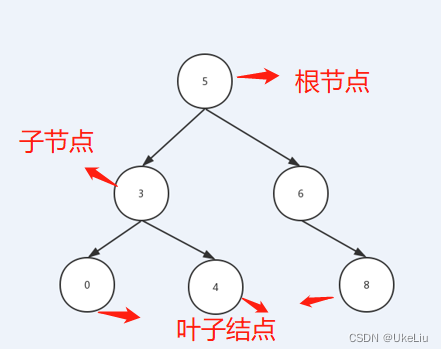
Traversal of binary tree
First, we implement a binary tree in the form of a linked list :
// Define the nodes of the tree
class treeNode{
private int data; // data
private treeNode left; // The left node
private treeNode right; // Right node
private treeNode parent;// Parent node
public treeNode getParent() {
return parent;
}
public void setParent(treeNode parent) {
this.parent = parent;
}
public treeNode(int data, treeNode left, treeNode right) {
this.data = data;
this.left = left;
this.right = right;
}
public treeNode(int data){
this.data = data;
this.left = null;
this.right = null;
}
public int getData() {
return data;
}
public void setData(int data) {
this.data = data;
}
public treeNode getLeft() {
return left;
}
public void setLeft(treeNode left) {
this.left = left;
}
public treeNode getRight() {
return right;
}
public void setRight(treeNode right) {
this.right = right;
}
}
// Method of outputting node data
public void print(treeNode treeNode){
System.out.println(treeNode.getData());
}
public static void main(String[] args) {
// Test the data
treeNode H=new treeNode('H',null,null);
treeNode K=new treeNode('k',null,null);
treeNode G=new treeNode('G',H,K);
treeNode F=new treeNode('F',G,null);
treeNode E=new treeNode('E',null,F);
treeNode D=new treeNode('D',null,null);
treeNode C=new treeNode('C',D,null);
treeNode B=new treeNode('B',null,C);
treeNode A=new treeNode('A',B,E);
BinaryTree binaryTree = new BinaryTree();
System.out.println(" front ---->");
binaryTree.pre(A);
System.out.println();
System.out.println(" in ---->");
binaryTree.in(A);
System.out.println();
System.out.println(" after ---->");
binaryTree.post(A);
System.out.println();
}
What is implemented here is a binary tree as shown in the figure below :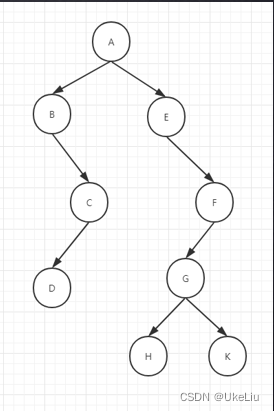
There are three ways to traverse a binary tree :
- The former sequence traversal : Root left and right ( Traverse from the root node of the binary tree , Output... In sequence ), You can understand this by looking at the root node first , There is direct output , Second, look at the left node , There is left node output , Let's see if the left node has a subtree , If so, repeat the above operation , The same is true for the right node , An algorithm idea of recursive backtracking is designed here .
- In the sequence traversal : Left root right
- After the sequence traversal : Left and right
These three traversal methods are actually from top to bottom , From bottom to top , There are also three traversal methods layer by layer , And the pithy formula is about the root , Left root right , Left and right .
Code implementation :
/** * The former sequence traversal Root left and right */
public void pre(treeNode treeNode){
print(treeNode);// Output root node data
if (treeNode.getLeft()!=null){
// The left node is not empty
pre(treeNode.getLeft()); // Recursion looks around the root
}
if (treeNode.getRight()!=null){
// Same as above
pre(treeNode.getRight());
}
}
/** * In the sequence traversal Left root right */
public void in(treeNode treeNode){
if (treeNode.getLeft()!=null){
in(treeNode.getLeft());
}
print(treeNode);
if (treeNode.getRight()!=null){
in(treeNode.getRight());
}
}
/** * In the sequence traversal Left and right */
public void post(treeNode treeNode){
if (treeNode.getLeft()!=null){
post(treeNode.getLeft());
}
if (treeNode.getRight()!=null){
post(treeNode.getRight());
}
print(treeNode);
}
The insertion of a binary tree : The insertion of binary tree is very simple , Because of his characteristics , Let's insert a number , Start at the root node , As long as it is smaller than the root node, go to the left , If it is larger than the root node, go to the right , Compare with the next node , Until the node being compared has no child nodes .
Code :
/** * Binary search tree inserts data * @param root The root node * @param data Inserted value */
public void insert(treeNode root,int data){
// Compare with the root node every time you insert
if (data<root.getData()){
// If it is smaller than the root node, go to the left
if (root.getLeft()==null){
// If it's a leaf node Add the node directly to the left of the leaf node
treeNode treeNode = new treeNode(data, null, null);
treeNode.setParent(root); // Set the parent node of the newly inserted node
root.setLeft(treeNode);
}else {
insert(root.getLeft(),data);
}
}else {
if (root.getRight()==null){
treeNode treeNode = new treeNode(data, null, null);
treeNode.setParent(root);;
root.setRight(treeNode);
}else {
insert(root.getRight(),data);
}
}
}
The deletion of binary trees
Deleting a binary tree is the hardest , But it is not the deletion operation that is rare , It's about the direction of the pointer , The deletion of binary tree can be divided into three cases :
The node to be deleted is the leaf node , In this case , Just delete it directly , Because he has no complicated pointing problem , The time complexity is O(1)
The deleted nodes have left or right subtrees , This situation is also very simple. Just point its child node to its parent node , Time complexity is also O(1)
The deleted node has left and right subtrees , At this time, we need to find its successor node or predecessor node , The next node is the smallest number in his right subtree , The predecessor node is the largest number in the left subtree .
Let's take the following node as an example , Replace the location of the deleted node with a successor node , At this time, the subsequent nodes are also deleted , We also need to consider whether there is a right subtree in the subsequent node , Subsequent nodes are certain that there is no left subtree , Because the successor node is the smallest number of the right subtree of the deleted node , Then we will go to the left , Until the leftmost number is found, it is the successor node .
The code is more complex , I annotated it more carefully , If you have something you don't understand, you can leave a message , See will give you an answer
class treeNode{
private int data; // data
private treeNode left; // The left node
private treeNode right; // Right node
private treeNode parent;// Parent node
public treeNode getParent() {
return parent;
}
public void setParent(treeNode parent) {
this.parent = parent;
}
public treeNode(int data, treeNode left, treeNode right) {
this.data = data;
this.left = left;
this.right = right;
}
public treeNode(int data){
this.data = data;
this.left = null;
this.right = null;
}
public int getData() {
return data;
}
public void setData(int data) {
this.data = data;
}
public treeNode getLeft() {
return left;
}
public void setLeft(treeNode left) {
this.left = left;
}
public treeNode getRight() {
return right;
}
public void setRight(treeNode right) {
this.right = right;
}
}
/** * Use linked list to realize binary tree */
public class BinaryTree {
public static void main(String[] args) {
BinaryTree binaryTree = new BinaryTree();
treeNode root = null;
Scanner cin = new Scanner(System.in);
int t = 1;
System.out.println(" Binary search tree assumes no duplicate child nodes , Repetition can be handled by linked list , Please note that ~~");
System.out.println(" Please enter the root node :");
int rootData = cin.nextInt();
root = new treeNode(rootData);
System.out.println(" Please enter the first " + t + " A little bit : Input -1 End of the said ");
while (true) {
//
int data = cin.nextInt();
if (data == -1)
break;
binaryTree.insert(root, data);
t++;
System.out.println(" Please enter the first " + t + " A little bit : Input -1 End of the said ");
}
binaryTree.show(root); // Find someone else to write a printed binary tree structure , It feels good , It can be clearer
System.out.println(" Delete the test :");
while(true) {
System.out.println(" Please enter the point to delete :-1 End of the said ");
int key = cin.nextInt();
root = binaryTree.delNode(key,root);
binaryTree.show(root);
if(root == null) {
System.out.println(" The tree has no data ~~");
break;
}
}
}
public void print(treeNode treeNode){
System.out.println(treeNode.getData());
}
// Used to get the number of layers of the tree
public int getTreeDepth(treeNode root) {
return root == null ? 0 : (1 + Math.max(getTreeDepth(root.getLeft()), getTreeDepth(root.getRight())));
}
private void writeArray(treeNode currNode, int rowIndex, int columnIndex, String[][] res, int treeDepth) {
// Ensure the input tree is not empty
if (currNode == null)
return;
// First, save the current node to a two-dimensional array
res[rowIndex][columnIndex] = String.valueOf(currNode.getData());
// Calculate the current layer of the tree
int currLevel = ((rowIndex + 1) / 2);
// If you get to the last floor , Then return to
if (currLevel == treeDepth)
return;
// Calculate the current line to the next line , The interval between each element ( The interval between the next row's column index and the current element's column index )
int gap = treeDepth - currLevel - 1;
// Judge the left son , If there is a left son , Record the corresponding "/" And left son's value
if (currNode.getLeft() != null) {
res[rowIndex + 1][columnIndex - gap] = "/";
writeArray(currNode.getLeft(), rowIndex + 2, columnIndex - gap * 2, res, treeDepth);
}
// Judge the right son , If there is a right son , Record the corresponding "\" With the right son's value
if (currNode.getRight() != null) {
res[rowIndex + 1][columnIndex + gap] = "\\";
writeArray(currNode.getRight(), rowIndex + 2, columnIndex + gap * 2, res, treeDepth);
}
}
/** * Show the binary tree * @param root */
public void show(treeNode root) {
if (root == null) {
System.out.println("EMPTY!");
return ;
}
// Get the depth of the tree
int treeDepth = getTreeDepth(root);
// The width of the last line is 2 Of (n - 1) Power multiplication 3, add 1
// As the width of the entire two-dimensional array
int arrayHeight = treeDepth * 2 - 1;
int arrayWidth = (2 << (treeDepth - 2)) * 3 + 1;
// Use an array of strings to store the elements that should be displayed at each location
String[][] res = new String[arrayHeight][arrayWidth];
// Initialize the array , The default is a space
for (int i = 0; i < arrayHeight; i++) {
for (int j = 0; j < arrayWidth; j++) {
res[i][j] = " ";
}
}
// Start at the root node , Recursively process the entire tree
writeArray(root, 0, arrayWidth / 2, res, treeDepth);
// here , All the elements that need to be displayed have been stored in a two-dimensional array , It can be spliced and printed
for (String[] line : res) {
StringBuilder sb = new StringBuilder();
for (int i = 0; i < line.length; i++) {
sb.append(line[i]);
if (line[i].length() > 1 && i <= line.length - 1) {
i += line[i].length() > 4 ? 2 : line[i].length() - 1;
}
}
System.out.println(sb.toString());
}
}
/** * Binary search tree inserts data * @param root The root node * @param data Inserted value */
public void insert(treeNode root,int data){
// Compare with the root node every time you insert
if (data<root.getData()){
// If it is smaller than the root node, go to the left
if (root.getLeft()==null){
// If it's a leaf node Add the node directly to the left of the leaf node
treeNode treeNode = new treeNode(data, null, null);
treeNode.setParent(root); // Set the parent node of the newly inserted node
root.setLeft(treeNode);
}else {
insert(root.getLeft(),data);
}
}else {
if (root.getRight()==null){
treeNode treeNode = new treeNode(data, null, null);
treeNode.setParent(root);;
root.setRight(treeNode);
}else {
insert(root.getRight(),data);
}
}
}
/** * Binary tree deletes node data * @param data */
public treeNode delNode(int data,treeNode root){
// Find this node . Traverse the tree
treeNode delNode = selectNode(data, root);
// Node not found
if (delNode==null){
System.out.println(" The deleted node does not exist in the tree ");
}
if (root==delNode){
return null;
}
// If this node is a leaf node Just delete
if (delNode.getRight()==null && delNode.getLeft()==null){
treeNode parent = delNode.getParent();
// Judge which side the node is on
if (delNode.getData()< parent.getData()){
// On the left
parent.setLeft(null);
}else {
parent.setRight(null);
}
}else if (delNode.getRight()!=null && delNode.getLeft()!=null){
// Deleted nodes There are two child nodes
// Find subsequent nodes
treeNode successorNode = selectSuccessorNode(delNode);
successorNode.setLeft(delNode.getLeft()); // Point the left subtree of the deleted point to the left of the subsequent node
successorNode.getLeft().setParent(successorNode); // Point the parent node of the left subtree to the successor node
// The left node of the subsequent node must be empty , We need to judge whether the right node of the successor node has a value
if (successorNode.getRight()==null){
// If the successor node has no right node Directly delete the subsequent nodes
if(delNode!=successorNode.getParent()){
// Point the right subtree of the subsequent node to the right subtree of the deleted node
successorNode.setRight(delNode.getRight());
// Point the parent node on the right of the deleted node to the successor node
delNode.getRight().setParent(successorNode);
// Delete subsequent nodes
successorNode.getParent().setLeft(null);
}
}else if (successorNode.getRight()!=null && delNode!=successorNode.getParent()){
// Point the right subtree of the subsequent node to the right subtree of the deleted node
successorNode.setRight(delNode.getRight());
// Point the parent node on the right of the deleted node to the successor node
delNode.getRight().setParent(successorNode);
// Point the parent node of the right subtree of the successor node to the left subtree of the parent node of the successor node
successorNode.getRight().setParent(successorNode.getParent());
// Point the left subtree of the parent node of the successor node to the right subtree of the successor node
successorNode.getParent().setLeft(successorNode.getRight());
}
// Pointer replacement complete The next step is to delete nodes
if (delNode==root){
successorNode.setParent(null);
root=successorNode;
return root;
}
successorNode.setParent(delNode.getParent());
// Determine whether the deleted point is on the left or right of the parent node
if (delNode.getParent().getData()>delNode.getData()){
// On the left
delNode.getParent().setLeft(successorNode);
}else {
delNode.getParent().setRight(successorNode);
}
}else{
// Delete node has only one child
if (delNode.getRight()!=null){
// Only the right node
if (delNode==root){
root=delNode.getRight();
return root;
}
delNode.getRight().setParent(delNode.getParent());
// Determine whether the deleted point is on the left or right of the parent node
if (delNode.getParent().getData()>delNode.getData()){
// On the left
delNode.getParent().setLeft(delNode.getRight());
}else {
delNode.getParent().setRight(delNode.getRight());
}
}else {
// Only the left node
if (delNode==root){
root=delNode.getLeft();
return root;
}
delNode.getLeft().setParent(delNode.getParent());
// Determine whether the deleted point is on the left or right of the parent node
if (delNode.getParent().getData()>delNode.getData()){
// On the left
delNode.getParent().setLeft(delNode.getLeft());
}else {
delNode.getParent().setRight(delNode.getLeft());
}
}
}
return root;
}
/** * There are two ways to delete a binary tree One is to find the predecessor node : Find the number on the left side of the node that is greater than the value of the node * Find the successor node of the node : Find the number of the right node that is the smallest than the node value * This method is used to find subsequent nodes The code of the previous node is the same Just find the direction and change it * @param node * @return */
public treeNode selectSuccessorNode(treeNode node){
// Find the number of all nodes on the right of the node that are smaller than the node
if (node.getRight()==null){
// It indicates that there is no successor node
return node;
}
treeNode cur=node.getRight();
treeNode pre=node.getRight(); // Open an extra space for storage node Because when node When the left node is empty , The previous node is returned
while (cur!=null){
pre=cur;
cur=cur.getLeft();
}
return pre;
}
/** * Find the node that needs to be deleted * @data Node data * @root The root node * @return Deleted nodes */
public treeNode selectNode(int data,treeNode root){
treeNode current=root;
while (current != null){
if (current.getData()<data){
current=current.getRight();
}else if (current.getData()>data){
current=current.getLeft();
}else {
return current;
}
}
return null;
}
}
边栏推荐
- Rasa 3.x 学习系列-Rasa X 社区版(免费版) 更改
- 上门预约服务类的App功能详解
- openssl-1.0.2k版本升级openssl-1.1.1p
- 俄外交部:日韩参加北约峰会影响亚洲安全稳定
- 2022.7.5-----leetcode.729
- Qcombox (rewrite) + qcompleter (auto completion, auto loading the drop-down options of qcombox, setting the background color)
- C # input how many cards are there in each of the four colors.
- What if the C disk is not enough? Let's see how I can clean up 25g of temp disk space after I haven't redone the system for 4 years?
- TS type declaration
- The use of El cascader and the solution of error reporting
猜你喜欢

【在线聊天】原来微信小程序也能回复Facebook主页消息!

GFS Distributed File System

开源crm客户关系统管理系统源码,免费分享

Do you regret becoming a programmer?

上门预约服务类的App功能详解

Problem solving win10 quickly open ipynb file
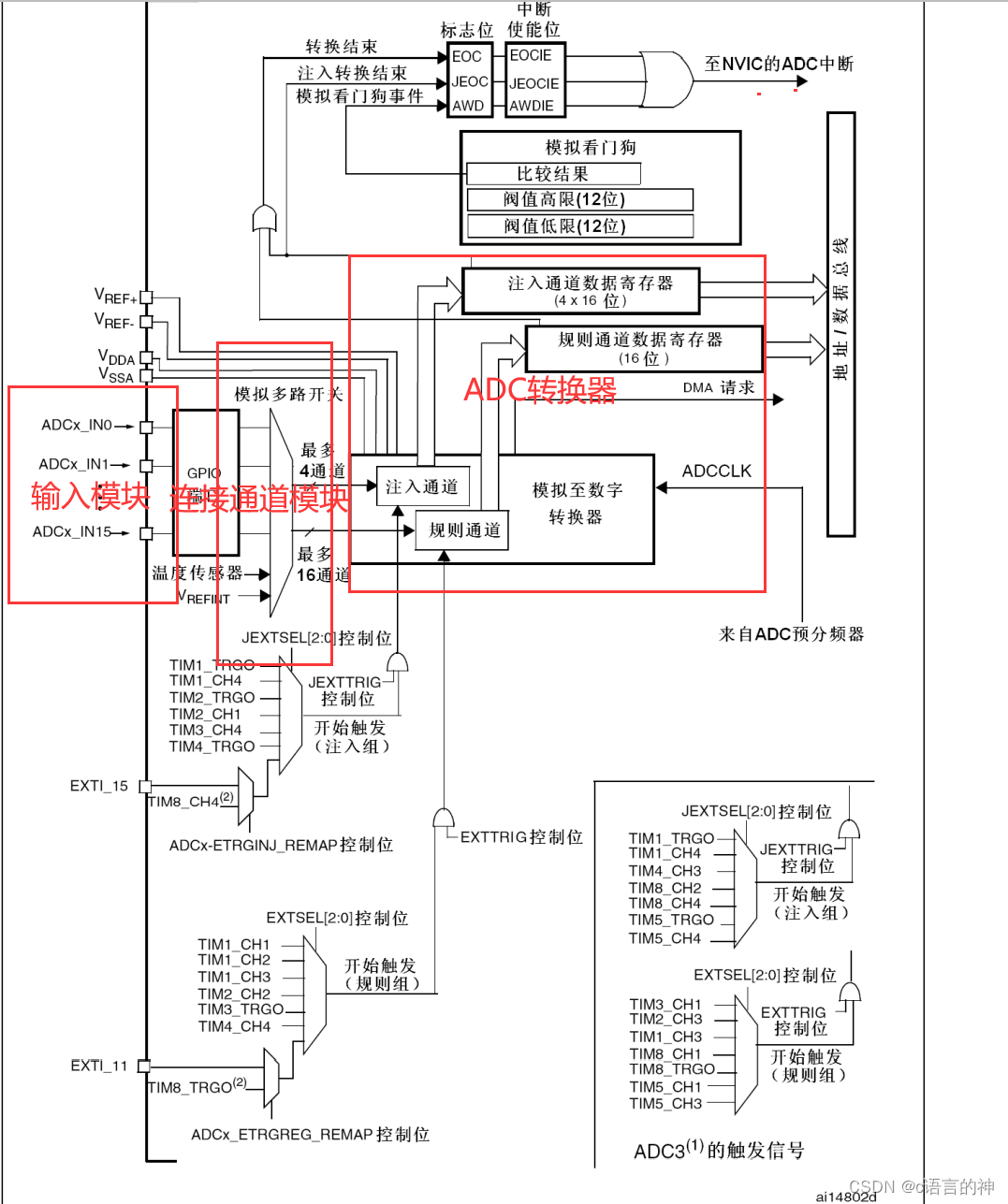
STM32__06—单通道ADC
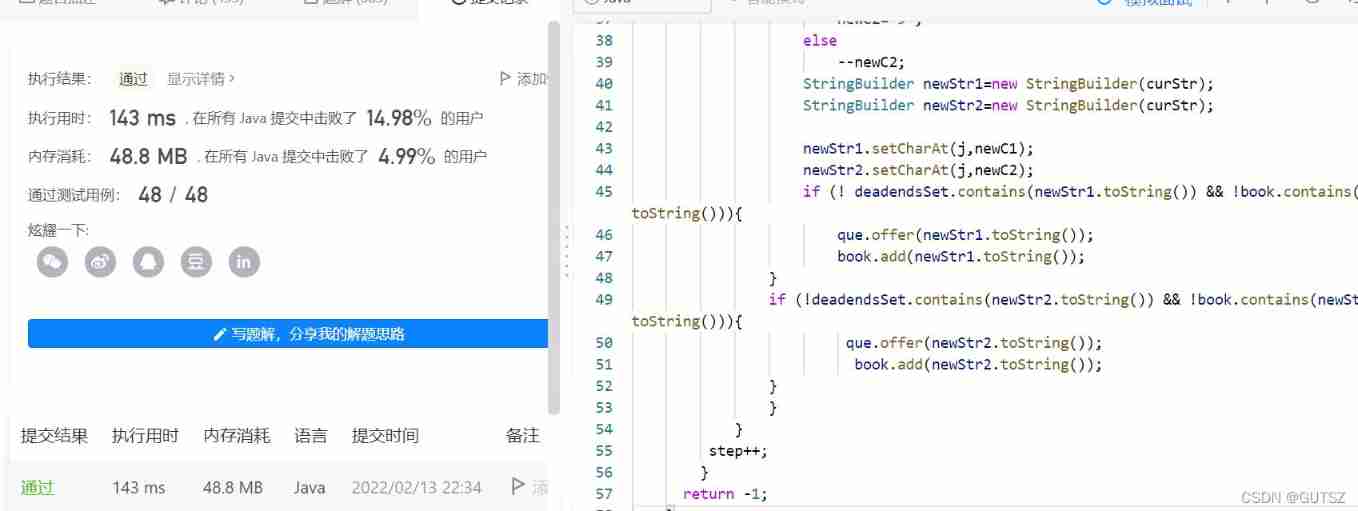
Breadth first search open turntable lock
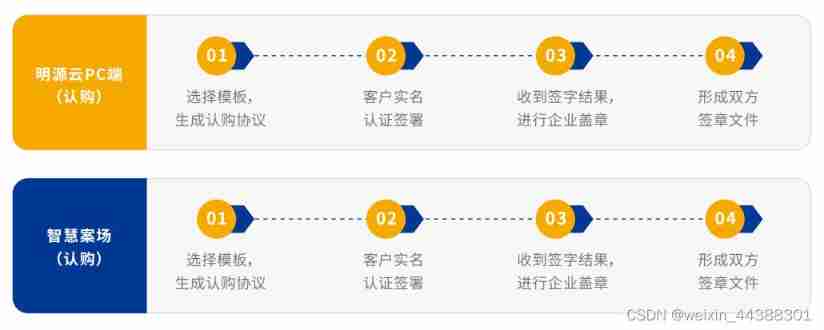
China Jinmao online electronic signature, accelerating the digitization of real estate business

Spreadjs 15.1 CN and spreadjs 15.1 en
随机推荐
Spire Office 7.5.4 for NET
Rasa 3. X learning series -rasa 3.2.1 new release
C # input how many cards are there in each of the four colors.
Open source CRM customer relationship system management system source code, free sharing
4 points tell you the advantages of the combination of real-time chat and chat robots
15 MySQL-存储过程与函数
上门预约服务类的App功能详解
Zero rhino technology joined hands with the intelligence Club: the "causal faction" forum was successfully held, and the "causal revolution" brought the next generation of trusted AI
15 MySQL stored procedures and functions
多普勒效应(多普勒频移)
关于结构体所占内存大小知识
QT QPushButton details
[SQL] SQL expansion languages of mainstream databases (T-SQL, pl/sql, pl/pgsql)
Rasa 3.x 学习系列-Rasa X 社区版(免费版) 更改
Online yaml to CSV tool
How to rotate the synchronized / refreshed icon (EL icon refresh)
Hcip course notes-16 VLAN, three-tier architecture, MPLS virtual private line configuration
How to improve eloquence
Spire.PDF for NET 8.7.2
Single merchant v4.4 has the same original intention and strength!